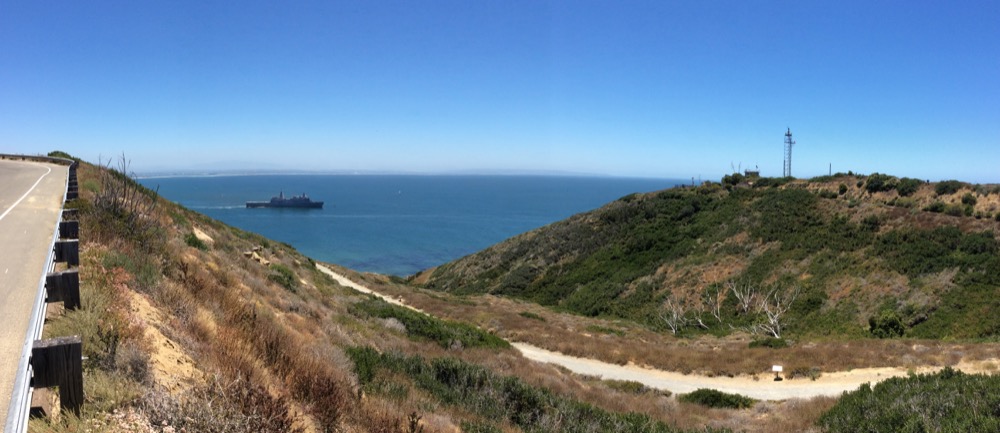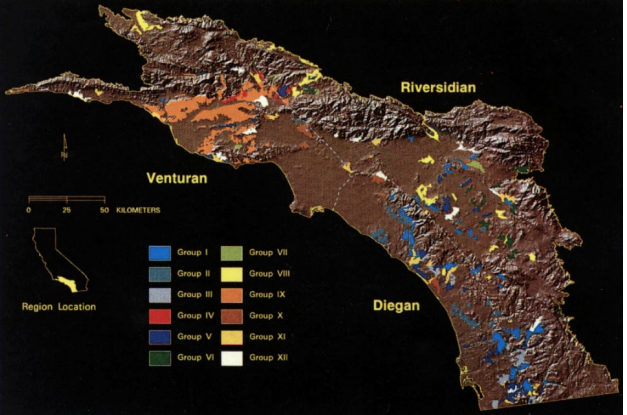 Photo by chezasaurus at iNaturalist.org – a black-capped male California Gnatcatcher (Polioptila californica californica) perched on a branch.
Photo by chezasaurus at iNaturalist.org – a black-capped male California Gnatcatcher (Polioptila californica californica) perched on a branch.The coastal subspecies of California Gnatcatcher (Polioptila californica californica) was listed as “threatened” under the Endangered Species Act in 1993 due in part to its preferred habitat. Gnatcatchers live in a plant community called Coastal Sage Scrub. True to its namesake, this community only grows along the coast, from Ventura County to northern Baja California. Unfortunately, we humans really love the beach and greatly prize that beachfront property; as such, development has decreased and fragmented the critical Coastal Sage Scrub habitat to 85 – 90% of what it used to be.
 NPS Photo – The Coastal Sage Scrub (forefront) and Maritime Chaparral (distance) plant communities at Cabrillo National Monument.
NPS Photo – The Coastal Sage Scrub (forefront) and Maritime Chaparral (distance) plant communities at Cabrillo National Monument. Image courtesy of the Journal of Vegetation Science 5: 743 – 756 – The remnants of Coastal Sage Scrub communities in Southern California from a paper published in 1994. The “groups” represent different classes (or species) of Coastal Sage Scrub plants.
Image courtesy of the Journal of Vegetation Science 5: 743 – 756 – The remnants of Coastal Sage Scrub communities in Southern California from a paper published in 1994. The “groups” represent different classes (or species) of Coastal Sage Scrub plants.Urbanization and fragmentation are not the only threats to the California Gnatcatcher, however. There is another culprit in this survival story – an innocent-looking bird called the Brown-headed Cowbird (Molothrus ater). But this bird neither predates upon (eats) nor outcompetes the California Gnatcatcher for resources. The Brown-headed Cowbird is problematic for the gnatcatcher because it’s a nest (or brood) parasite – it sneaks one of its eggs into a California Gnatcatcher nest (instead of creating a nest of its own) hoping that the gnatcatcher parents will rear the cowbird young. The cowbird egg hatches early, and the larger chick hogs all of the food, thereby decreasing the chances that the gnatcatcher chicks will survive. Normally, the species that is having its nest parasitized will have defense mechanisms against this sneaky act – the parents might recognize the intruder egg and eject it from the nest, for example. However, since Brown-headed Cowbirds are not native to this region (they’re originally from the prairies of the Midwest), local birds have not evolved any defenses, making them vulnerable to this sneaky behavior.

Photo by cobal at iNaturalist.org – A male Brown-headed Cowbird (Molothrus ater) standing on a fence.
 Photo courtesy of Friends of Sam Smith Park – A large Brown-headed Cowbird (Molothrus ater) chick being fed by a much smaller warbler parent.
Photo courtesy of Friends of Sam Smith Park – A large Brown-headed Cowbird (Molothrus ater) chick being fed by a much smaller warbler parent.The story of the California Gnatcatcher is a perfect example of why we wholeheartedly embrace our mission here in the National Park Service. Preserving and protecting our nation’s resources gives organisms, like the gnatcatcher, a refuge from the exploding human population and its encroachment. Our mission even affords a refuge for humans, as it preserves our beautiful land for generations to come. So, the next time you’re walking around Cabrillo listen for a tiny mewling and look for a small, gray songbird with an upright black tail – we hope the California Gnatcatcher will remind you of why your national parks are “America’s best idea.”
References
California Gnatcatcher:
https://www.allaboutbirds.org/guide/California_Gnatcatcher/overview
https://www.biologicaldiversity.org/species/birds/coastal_California_gnatcatcher/index.html
https://www.audubon.org/field-guide/bird/california-gnatcatcher
Coastal Sage Scrub:
http://ca.audubon.org/news/rare-coastal-sage-scrub-habitat-provides-home-threatened-gnatcatcher-and-many-other-species
https://onlinelibrary.wiley.com/doi/abs/10.2307/3235887
Brown-headed Cowbird:
https://www.allaboutbirds.org/guide/Brown-headed_Cowbird/overview
http://www.friendsofsamsmithpark.ca/2015/06/brown-headed-cowbird-brood-parasitism.html
